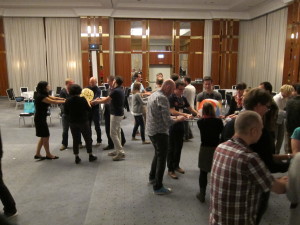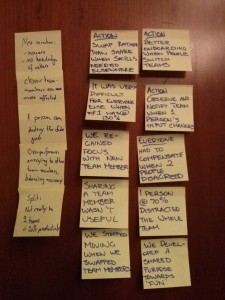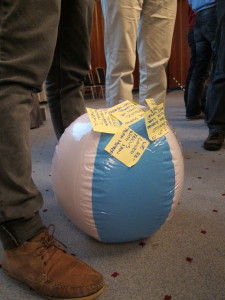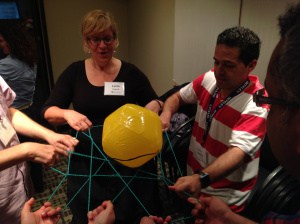Intention of the game
The intention of the game is to
- experience sharing responsibility for a common purpose
- discover unhealthy team dynamics and
- reflect and think about better ways to work together.
I use the game as a start into a longer retrospective in which I like to focus on the topics of team dynamics, responsibilities and sharing of the workload.
Time
Time required: 45-75 min
Number of players
One or more teams of 5-8. The game is usually more fun with more than one team, but especially if the team is an existing one, it can be a deep and helpful experience to play it alone.
Materials
- big loops of rope – I use a thin rope, originally used to brace tents which I bought at my local outdoor shop. Take 6.5M long pieces per group and knot them together so they form a loop. For bigger groups, you may want a longer rope.
- beach balls – or other light balls (balloons, playground balls) roughly the size of a soccer ball.
- lots of open space where the teams can walk around
The game
The game is best played with existing teams. he “teams” in the game should be the same as in real life. If you are playing with a bunch of people that would like to experience the game, let them randomly form teams of 5-8 people.
Give each team a few minutes to talk about their shared purpose – in an existing team they hopefully already have some understanding of that. If you play this with random people just let them find a shared purpose in one minute (a shared purpose is something where each team member cares about it at least a little, i.e. advancing our practice of software development, creating happy workplaces, saving the earth…)
Let each person grab onto the loop with two hands. The team members should count off so that they know who is team member #1, team member #2,…through to team member #8.
Then each team forms a net of the loop by passing the rope to each other until the net is formed.
Place a ball in the middle of each team’s net. Tell them this represent their shared purpose – make it meaningful! (For example, I like to ask the team what their shared purpose is, and then say with a grave voice: “This represents …”) The teams work is to care for themselves and to treat their shared purpose with care – in terms of the game this means to keep the ball from falling down from the net.

Ask the teams to move around the room and allow them to experience how this feels. The following table describes some scenarios that you can guide the teams to do. I usually go back to the neutral scenario between the other ones. In all scenarios the team should keep moving.
| Scenario | What you ask a team to do | What I additionally say about it |
| Neutral | Walk around the room | „Projects are always moving, always alive, so keep moving.“ |
| 1. | Team member 1 takes 130% responsibility by pulling harder on the cord. | „You think you have to do everything. Without you everything will fall apart.“ |
| 2. | Team member 2 gives up some responsibility by loosening their grip on the cord | „You are tired of work, is has just become a nine-to-five job, internally you have already resigned.“ |
| 3. | Team members 3 & 5 have a conflict and try to pull apart while maintaining their grip on the net. | |
| 4. | Team member 6 leaves their home team and after a while joins another team | „You are an expert and your skills are needed elsewhere, leave the team…“ „You return from you external task, you old team has adapted, therefore we put you into a new team…“ |
| 5. | Team members 4 & 7 swap places | „You are changing roles.“ |
| 6. | Team member 8 works in two teams (multitasking) | „You are an expert and we need you in two teams.“ |
| 7. | Team member 9 works remotely, so close your eyes |
Adjust the numbers to your team sizes.
The debrief
This is a really powerful game for dramatizing what happens when teams are not aligned in intent or are in a position where team members are distracted from the shared purpose. I like to do little debriefs as you go: run two or three scenarios, then pause and encourage participants to reflect on how they are feeling right then, and how the current situation reflects circumstances that are present on their teams. You can frame this as a retrospective.
At the end of the game allow the teams a longer debrief and give them a few questions that they can talk about.
Debrief questions I use are:
- How does this reflect the way you work?
- Which elements of this game are a fitting reflection of the way we work, where does it not fit?
- What are the ropes symbolizing for you?
- Is giving and receiving in balance in our team? Are all of us present in the way we want to and in the way that serves the purpose?
- How are we taking care of our shared purpose? How would we like to change that?
- What painful observations of our current way of working become visible? What ideas do you already have to change those?
Let the teams first debrief just within the teams and then harvest the learning in a big circle of all team members. As debriefing is crucial for the learning to take place, leave enough time for it.
In a retrospective it is important to continue to work with the results and move towards actions and experiments.


Thanks
Thanks to Ellen Grove who did the first write-up of the game which I used as the base for this article, to all the teams and conference participants who participated so enthusiastic in exploring the game and especially to Gregg Kendrick who introduced me to an initial version of this game.
